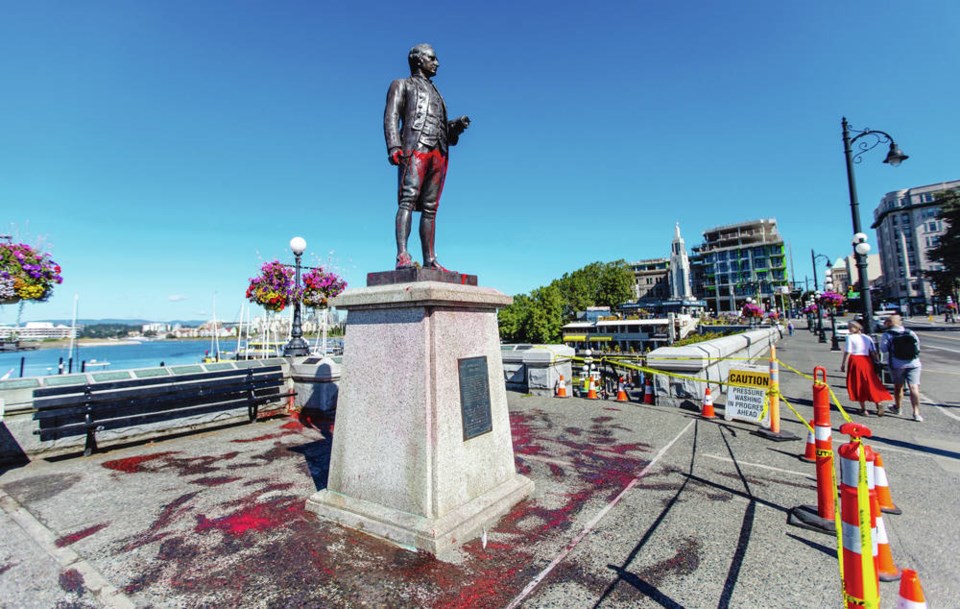At a time when conspicuous ignorance and revisionist history has become a “thing” with little or no shame or embarrassment attached, the vandalizing of the harbourside statue of James Cook should come as no surprise.
Throwing a can of paint onto a statue requires no skill, courage and intelligence — at least not the kind that enabled Cook to set out from the English port of Plymouth on Aug. 26, 1768, in the small wooden HM Bark Endeavour to explore an unknown and perilous world.
Cook’s assignment was simple: Sail thousands of miles across largely uncharted areas of the globe, and map lands (if they existed) from New Zealand to Hawaii in the Pacific Ocean.
Cook’s task was to map the south Pacific in greater detail on a scale not previously charted by Western explorers. Cook surveyed and named features and meticulously recorded islands and coastlines on European maps for the first time.
According to Admiralty records of the time, Cook displayed a combination of “seamanship, superior surveying and cartographic skills, physical courage and an ability to lead men in adverse conditions.”
All this at a time when many still believed the Earth was flat and it was thought possible to sail off the edge and disappear. Exploration was dangerous, and many explorers lost their lives in shipwrecks and from starvation, exposure to the harsh elements, scurvy and battle.
In March 1778, Cook was headed north along what is now the northwest coast of Canada.
His ship, the Resolution, was short of drinking water and badly in need of repairs, when the lookout spotted a gap in the coastline.
According to records of the time, the Resolution was approached by canoes launched by the local Muchalaht people. It was a friendly encounter, and throughout Cook’s five-week stay, trade — mostly furs and fish in return for iron implements — was “brisk.”
Cook eventually died at the hands of Indigenous Hawaiians near Kona on the island of Hawaii after an attempt to kidnap a Hawaiian chief as hostage against the return of a stolen rowboat.
Of course, that was then and this is now, and it is impossible to gauge what defined the relationship between early explorers such as Cook and the Indigenous Peoples they came across on their journeys.
Indigenous societies were long established before expeditions of British, French, Spanish and Dutch exploration would gain valuable navigational information about the unknown world.
Sometimes the explorers would invite or force Indigenous people of the northwest and south Pacific to come aboard, some unwillingly, as advisers and interpreters.
This practice presumably came as no surprise to some coastal Northwestern tribal people who occasionally made forays themselves into the interior of British Columbia to take slaves from interior tribes; but that is another story, and hopefully will not result in some righteous soul throwing red paint on the many beautiful examples of Northwestern Indigenous art displayed around Victoria.
In elementary school, all I really knew about Cook was about the discovery of Botany Bay on April 29, 1770. This was the site of Cook’s first arrival on the land mass of Australia.
The landing in Botany Bay was followed by an arduous row north along the coast to discover Sydney Harbour (still one of the world’s great harbours), where the Opera House sits at Bennelong Point, named after an Indigenous man employed as a cultural interlocutor by the British and who persuaded Governor Arthur Phillip to build a brick hut for him on the point, giving it its name.
But again, like most of history, that’s another story about a different time, not to be judged by today’s standards.
Nonetheless, during a visit to Quebec City recently, I was surprised to find a statue of James Cook in front of the Chateau Frontenac.
What, I had wondered, was yet another statue of Cook doing in Quebec City?
It was Cook, apparently, who navigated the British up the St. Lawrence to a point where they were able to clamber up the muddy slope onto the Plains of Abraham, where they threw red paint at General Montcalm.
OK, no red paint, but a lot of blood spilt on both sides on Sept. 13, 1759, as the British army and Royal Navy fought against the French army — a battle thought by many historians to have been a deciding moment in the conflict between France and Britain that influenced the later creation of Canada.
It was Cook’s navigational achievement on this occasion that led to his commission in 1766 as commander of HM Bark Endeavour for the first of three Pacific voyages.
No doubt the gormless “yob” (Australian for a “backward boy”) knew all this background about Cook’s history as he threw paint on the Cook statue in Victoria.
Or more likely not.
In a previous column, I wrote about “presentism,” the misguided current tendency to judge events that occurred in a different time and a different place under different circumstances when different understandings governed what was morally acceptable.
Different opinions some hundreds of years ago defined actions that today conveniently fire up the moral outrage of today’s “holier than thou” brigade and the mindless vandalizing of statues such as Cook’s.
But Marcus Aurelius, Roman emperor from 161 to 180, had it right when he wrote in his Meditations: “Waste no more time arguing about what a good man should be. Be one.”
gfjohnson4@shaw.ca
Geoff Johnson is a former superintendent of schools.



